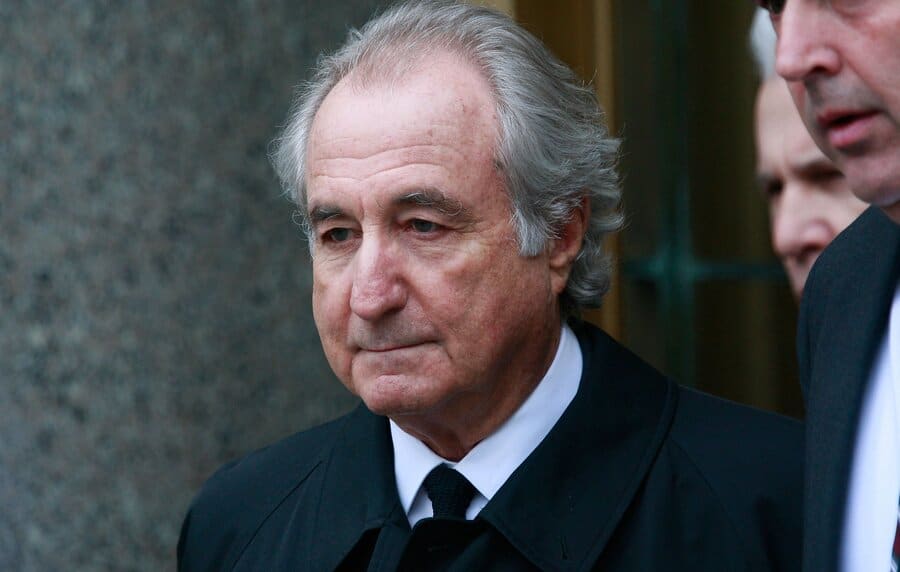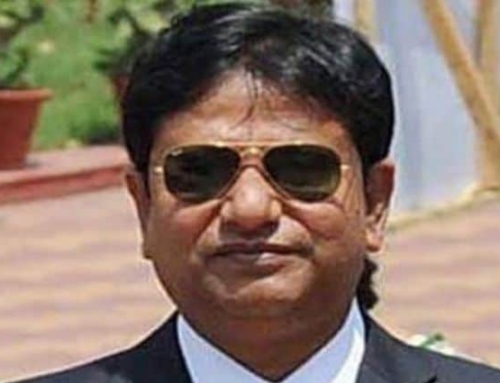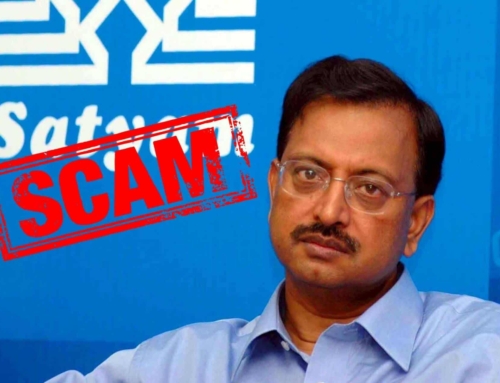Bernie Madoff Scandal – Ponzi Scheme
Bernard Lawrence Madoff, the American financier and the former Nasdaq chairman, executed an investment scandal, which was a major case of stock and securities fraud discovered in late 2008.
In December of that year, Bernie Madoff, the founder of the Wall Street firm Bernard L. Madoff Investment Securities LLC, admitted that the wealth management arm of his business was a multi-billion-dollar Ponzi scheme. The fraud was worth $65 billions and is considered to be one of the biggest investment frauds in history.
When the fraud was unearthed, Bernie Madoff was charged with 11 counts of fraud, money laundering, perjury, and theft. He was also sentenced to 150 years of imprisonment. The US Securities and Exchange Commission was criticized for not doing a thorough investigation on the Madoff case.
The Background
Bernie Madoff founded Bernard L. Madoff Investment Securities LLC, in 1960 and was its chairman until his arrest.
He started this investment management firm and started trading and investing in penny stocks. He has been interested in the capital market since his initial career. And he had good contacts and friends who helped him grow his business. They gave him money to manage, as he assured them of good, consistent returns. His contacts further helped him grow his business and referred contacts, a circle of friends and families to keep their money with Madoff. This way he grew his client base.
Initially, the firm made money (quoted bid and ask prices) via the National Quotation Bureau’s Pink Sheets. To compete with firms that were members of the New York Stock Exchange trading on the stock exchange’s floor, his firm began using innovative computer information technology to disseminate quotes and this helped evolve the markets into a digital era.
And soon Madoff Securities became the largest buying and selling market maker at the NASDAQ. He was even appointed as the chairman of the board of directors at the National Association of Securities Dealers (NASD), a self-regulatory securities industry organization. In this business, he was helped by almost most of his family members.
Medoff started his Wall Street journey in the 1960s, through his investment management firm named Bernard L. Madoff Investment Securities LLC. Through this firm he mostly traded on the penny stocks. Penny stocks are companies that are small in size with limited information available on the public domain. These stocks are generally risky for anyone to invest in, as the credentials are not available.
Through his innovative use of technology he helped evolve the digital era and ended up being the pioneer of the NASDAQ stock exchanges and even served there as the chairman. His claim to fame was the software that was developed by his brother as it was said to pick profitable trades within a few seconds. A lot of people invested with Madoff and made good money giving his company a good reputation.
Madoff had three lines of business. Apart from brokerage, he also conducted proprietary trading. However, it was the hedge fund that was the crown jewel of his empire. This was personally managed by Bernie Madoff and was the epicenter of the gigantic $65 billion embezzlement or the fraud, probably the largest in world history.
The Illusion created by Bernie Madoff
Bernie Madoff’s hedge fund was a class apart. While other hedge funds were looked upon as speculators, Madoff was looked upon as an expert money manager. Other funds had erratic returns. Sometimes they would make a lot of money and at other times they would lose a lot. This is a fundamental characteristic of hedge funds and the basic reason why only accredited investors with more than a $200000 net worth can invest in them.
The average investor is kept away from hedge funds by the government because of the massive risks involved. Bernie’s fund had been giving a consistent return of close to 12% for decades. The fund had seemingly survived many recessions and crashes.
People would queue up to give Bernie their money and thus he gained immense power and prestige. Investors considered themselves lucky to give their money to Madoff to manage, whether it was domestic investors from the wealthy community, Hollywood celebrities, European financial institutions, or just independent investors, they all trusted Madoff to do his trading magic and take care of their money.
He was getting so many investors that he started to choose his investors, which in turn changed the perception of the firm to a premium investment firm, which invested for the selected investors only. He thus started his ponzi scheme then, where he promised good and consistent returns to the investors on low risk irrespective of the market situation. Investors were getting consistent returns on their investment irrespective of the market ups or downs.
He was getting more investors from all sectors and institutions who invested in him. And getting Bernie Madoff to manage their money became a status symbol amongst the wealthy as Bernie’s selectiveness gave him an aura of exclusivity and created a high-end brand.
In general, the ponzi schemes promise to give exceptionally good returns on the invested amounts, which raises alarm in the investors’ mind. And when they fail to give back the return, their scheme gets exposed.
But in the case of Bernie, it was different, as he assured his investors of a consistent return with low risk. He was giving a consistent return of 12% to 13% to his investors, which made them more than happy and safe. He executed this ponzi scheme for 20 long years in the most regulated markets of the world. This was unique as in general most schemes last for 4 to 5 years but this was an uncommon trend for the ponzi schemes. Now let us understand how he executed this ponzi scheme.
What Bernie Madoff Did
Since Bernie Madoff was giving consistent returns to his investors, they were happily investing with him without any doubts. But during the times of the market crash which happened in 1987 and many times later, it became difficult for Bernie to pay back his investors. Madoff had no magical way of navigating the ups and downs of the market and always creating a 12% return at the end of it.
In reality, Madoff was paying off the old investors by receiving money from the new ones. This is the very definition of a Ponzi scheme i.e. financial fraud. He continued doing this for a long time, without being noticed by the investors or the regulatory authorities.
Madoff was very selective about his investors because he mostly managed money for large charities and non-profit organizations and big institutions. Big companies like the Royal Bank of Scotland, HSBC, Royal Bank of Canada, Shell, AXA, BNP Paribas and many such big names These institutions were regulated by the law and had predictable withdrawal patterns.
Hence, Madoff maintained a percentage between the money managed for non-profits and the money managed for private individuals. This would enable him to make payments if demanded by the investors and thereby prevent the shortage of the funds.
Bernie’s clients always preferred to keep their money with him and he had very few withdrawals, so he was easily managing the funds without any shortage. But during the 2008 financial crisis, when most of the investors tried withdrawing their money, he faced issues in repaying them. As during the recession no new investors came to him for investment, rather the existing investors started withdrawing and he was unable to pay them, as he did not have funds.
And during this time, his ponzi scheme was exposed. He did not invest any of his investors’ money, rather just showed them fake transaction receipts and fake trading receipts and showed them where he invested their money. But in reality, he was keeping the money with himself only. He was able to do this with the help of a few of his advisors.
Bernie Madoff’s trusted advisors had set up an entire secret operation wherein they would always pay a 12% return on withdrawal or even in the annual statements. His advisors would simply reverse engineer the trades and claim to have purchased and sold certain securities which in respect would show the 12% return appear very probable.
An entire software unit was set up on the mysterious 17th floor of the office wherein these fabricated statements were created. Investors did not have online access to their accounts and as such they could not even check their statements real time.
Thus in 2008, the entire ponzi scheme came to light when his sons disclosed the matter in public. Bernie managed the scheme for a long time, but when he was unable to pay back his investors, he confessed the truth to his sons, who later revealed it to the media and FBI.
The Big Reveal
Madoff was said to have reported several times before the 2008 fallout. Few reporters and financial analysts also raised the alarm against him, but nothing happened. In fact, one investor, who was former forensic accounting and financial fraud investigator, Harry Markopolos had given a 21 page letter to the Boston SEC elaborating the reasons as to why Madoff Investments could not be a legitimate business operation.
Madoff’s significant influence in Washington and his family connection with the SEC department also played a major part in getting him off the hook multiple times. However, no charges of corruption had been proven against him and it also seemed that he simply bluffed the regulators several times and continued the Ponzi empire till it became fundamentally unsustainable in 2008.
He was said to have confessed the situation to his two sons who reported it immediately to the regulators since they did not want to be part of the scandal.
What happened after the reveal
His sons’, Mark and Andrew Madoff turned their father into the FBI, putting an end to the scheme. After his arrest and guilty plea in 2009, Madoff, in his seventies, was sentenced to 150 years in prison.
Madoff ran the most high-profile Ponzi scheme in history. The destruction he caused affected everyone he ever worked with. After his scheme fell apart, investors realized that they had lost billions of dollars. U.S. federal investigators continued to pursue suspects, including some other family members of Madoff. The estimated loss may have ranged from $50 billion to $65 billion, but investigators acknowledged that locating the missing funds might prove to be impossible.
Some former employees and associates were investigated or arrested for their involvement. Few committed suicide, including Madoff’s oldest son Mark, who committed suicide after two years of his arrest.
The United States government ended up offering to pay out more than $700 million to defrauded Madoff investors. But many investors still had to recover the invested amount. However, it is true that some of Madoff’s earliest investors did manage to recover their full investment amount plus a hefty profit.
To Conclude
One of the biggest lessons that the Madoff scheme taught investors was that Ponzi schemes can seem legitimate, so buyers should always be on the lookout for scams. Madoff’s practice seemed legitimate and was even praised by many Wall Street investors, despite the fact that his numbers simply didn’t add up. Before investing, you should look at the holdings of a fund and make sure that their performance is consistent with the activity of the stock market.
One should always look into the company’s credentials and its performance and keep a check of it and most importantly, to avoid being cheated by such ponzi schemes and frauds.
Bernie Madoff Scandal – Ponzi Scheme
Bernard Lawrence Madoff, the American financier and the former Nasdaq chairman, executed an investment scandal, which was a major case of stock and securities fraud discovered in late 2008.
In December of that year, Bernie Madoff, the founder of the Wall Street firm Bernard L. Madoff Investment Securities LLC, admitted that the wealth management arm of his business was a multi-billion-dollar Ponzi scheme. The fraud was worth $65 billions and is considered to be one of the biggest investment frauds in history.
When the fraud was unearthed, Bernie Madoff was charged with 11 counts of fraud, money laundering, perjury, and theft. He was also sentenced to 150 years of imprisonment. The US Securities and Exchange Commission was criticized for not doing a thorough investigation on the Madoff case.
The Background
Bernie Madoff founded Bernard L. Madoff Investment Securities LLC, in 1960 and was its chairman until his arrest.
He started this investment management firm and started trading and investing in penny stocks. He has been interested in the capital market since his initial career. And he had good contacts and friends who helped him grow his business. They gave him money to manage, as he assured them of good, consistent returns. His contacts further helped him grow his business and referred contacts, a circle of friends and families to keep their money with Madoff. This way he grew his client base.
Initially, the firm made money (quoted bid and ask prices) via the National Quotation Bureau’s Pink Sheets. To compete with firms that were members of the New York Stock Exchange trading on the stock exchange’s floor, his firm began using innovative computer information technology to disseminate quotes and this helped evolve the markets into a digital era.
And soon Madoff Securities became the largest buying and selling market maker at the NASDAQ. He was even appointed as the chairman of the board of directors at the National Association of Securities Dealers (NASD), a self-regulatory securities industry organization. In this business, he was helped by almost most of his family members.
Medoff started his Wall Street journey in the 1960s, through his investment management firm named Bernard L. Madoff Investment Securities LLC. Through this firm he mostly traded on the penny stocks. Penny stocks are companies that are small in size with limited information available on the public domain. These stocks are generally risky for anyone to invest in, as the credentials are not available.
Through his innovative use of technology he helped evolve the digital era and ended up being the pioneer of the NASDAQ stock exchanges and even served there as the chairman. His claim to fame was the software that was developed by his brother as it was said to pick profitable trades within a few seconds. A lot of people invested with Madoff and made good money giving his company a good reputation.
Madoff had three lines of business. Apart from brokerage, he also conducted proprietary trading. However, it was the hedge fund that was the crown jewel of his empire. This was personally managed by Bernie Madoff and was the epicenter of the gigantic $65 billion embezzlement or the fraud, probably the largest in world history.
The Illusion created by Bernie Madoff
Bernie Madoff’s hedge fund was a class apart. While other hedge funds were looked upon as speculators, Madoff was looked upon as an expert money manager. Other funds had erratic returns. Sometimes they would make a lot of money and at other times they would lose a lot. This is a fundamental characteristic of hedge funds and the basic reason why only accredited investors with more than a $200000 net worth can invest in them.
The average investor is kept away from hedge funds by the government because of the massive risks involved. Bernie’s fund had been giving a consistent return of close to 12% for decades. The fund had seemingly survived many recessions and crashes.
People would queue up to give Bernie their money and thus he gained immense power and prestige. Investors considered themselves lucky to give their money to Madoff to manage, whether it was domestic investors from the wealthy community, Hollywood celebrities, European financial institutions, or just independent investors, they all trusted Madoff to do his trading magic and take care of their money.
He was getting so many investors that he started to choose his investors, which in turn changed the perception of the firm to a premium investment firm, which invested for the selected investors only. He thus started his ponzi scheme then, where he promised good and consistent returns to the investors on low risk irrespective of the market situation. Investors were getting consistent returns on their investment irrespective of the market ups or downs.
He was getting more investors from all sectors and institutions who invested in him. And getting Bernie Madoff to manage their money became a status symbol amongst the wealthy as Bernie’s selectiveness gave him an aura of exclusivity and created a high-end brand.
In general, the ponzi schemes promise to give exceptionally good returns on the invested amounts, which raises alarm in the investors’ mind. And when they fail to give back the return, their scheme gets exposed.
But in the case of Bernie, it was different, as he assured his investors of a consistent return with low risk. He was giving a consistent return of 12% to 13% to his investors, which made them more than happy and safe. He executed this ponzi scheme for 20 long years in the most regulated markets of the world. This was unique as in general most schemes last for 4 to 5 years but this was an uncommon trend for the ponzi schemes. Now let us understand how he executed this ponzi scheme.
What Bernie Madoff Did
Since Bernie Madoff was giving consistent returns to his investors, they were happily investing with him without any doubts. But during the times of the market crash which happened in 1987 and many times later, it became difficult for Bernie to pay back his investors. Madoff had no magical way of navigating the ups and downs of the market and always creating a 12% return at the end of it.
In reality, Madoff was paying off the old investors by receiving money from the new ones. This is the very definition of a Ponzi scheme i.e. financial fraud. He continued doing this for a long time, without being noticed by the investors or the regulatory authorities.
Madoff was very selective about his investors because he mostly managed money for large charities and non-profit organizations and big institutions. Big companies like the Royal Bank of Scotland, HSBC, Royal Bank of Canada, Shell, AXA, BNP Paribas and many such big names These institutions were regulated by the law and had predictable withdrawal patterns.
Hence, Madoff maintained a percentage between the money managed for non-profits and the money managed for private individuals. This would enable him to make payments if demanded by the investors and thereby prevent the shortage of the funds.
Bernie’s clients always preferred to keep their money with him and he had very few withdrawals, so he was easily managing the funds without any shortage. But during the 2008 financial crisis, when most of the investors tried withdrawing their money, he faced issues in repaying them. As during the recession no new investors came to him for investment, rather the existing investors started withdrawing and he was unable to pay them, as he did not have funds.
And during this time, his ponzi scheme was exposed. He did not invest any of his investors’ money, rather just showed them fake transaction receipts and fake trading receipts and showed them where he invested their money. But in reality, he was keeping the money with himself only. He was able to do this with the help of a few of his advisors.
Bernie Madoff’s trusted advisors had set up an entire secret operation wherein they would always pay a 12% return on withdrawal or even in the annual statements. His advisors would simply reverse engineer the trades and claim to have purchased and sold certain securities which in respect would show the 12% return appear very probable.
An entire software unit was set up on the mysterious 17th floor of the office wherein these fabricated statements were created. Investors did not have online access to their accounts and as such they could not even check their statements real time.
Thus in 2008, the entire ponzi scheme came to light when his sons disclosed the matter in public. Bernie managed the scheme for a long time, but when he was unable to pay back his investors, he confessed the truth to his sons, who later revealed it to the media and FBI.
The Big Reveal
Madoff was said to have reported several times before the 2008 fallout. Few reporters and financial analysts also raised the alarm against him, but nothing happened. In fact, one investor, who was former forensic accounting and financial fraud investigator, Harry Markopolos had given a 21 page letter to the Boston SEC elaborating the reasons as to why Madoff Investments could not be a legitimate business operation.
Madoff’s significant influence in Washington and his family connection with the SEC department also played a major part in getting him off the hook multiple times. However, no charges of corruption had been proven against him and it also seemed that he simply bluffed the regulators several times and continued the Ponzi empire till it became fundamentally unsustainable in 2008.
He was said to have confessed the situation to his two sons who reported it immediately to the regulators since they did not want to be part of the scandal.
What happened after the reveal
His sons’, Mark and Andrew Madoff turned their father into the FBI, putting an end to the scheme. After his arrest and guilty plea in 2009, Madoff, in his seventies, was sentenced to 150 years in prison.
Madoff ran the most high-profile Ponzi scheme in history. The destruction he caused affected everyone he ever worked with. After his scheme fell apart, investors realized that they had lost billions of dollars. U.S. federal investigators continued to pursue suspects, including some other family members of Madoff. The estimated loss may have ranged from $50 billion to $65 billion, but investigators acknowledged that locating the missing funds might prove to be impossible.
Some former employees and associates were investigated or arrested for their involvement. Few committed suicide, including Madoff’s oldest son Mark, who committed suicide after two years of his arrest.
The United States government ended up offering to pay out more than $700 million to defrauded Madoff investors. But many investors still had to recover the invested amount. However, it is true that some of Madoff’s earliest investors did manage to recover their full investment amount plus a hefty profit.
To Conclude
One of the biggest lessons that the Madoff scheme taught investors was that Ponzi schemes can seem legitimate, so buyers should always be on the lookout for scams. Madoff’s practice seemed legitimate and was even praised by many Wall Street investors, despite the fact that his numbers simply didn’t add up. Before investing, you should look at the holdings of a fund and make sure that their performance is consistent with the activity of the stock market.
One should always look into the company’s credentials and its performance and keep a check of it and most importantly, to avoid being cheated by such ponzi schemes and frauds.








Leave A Comment